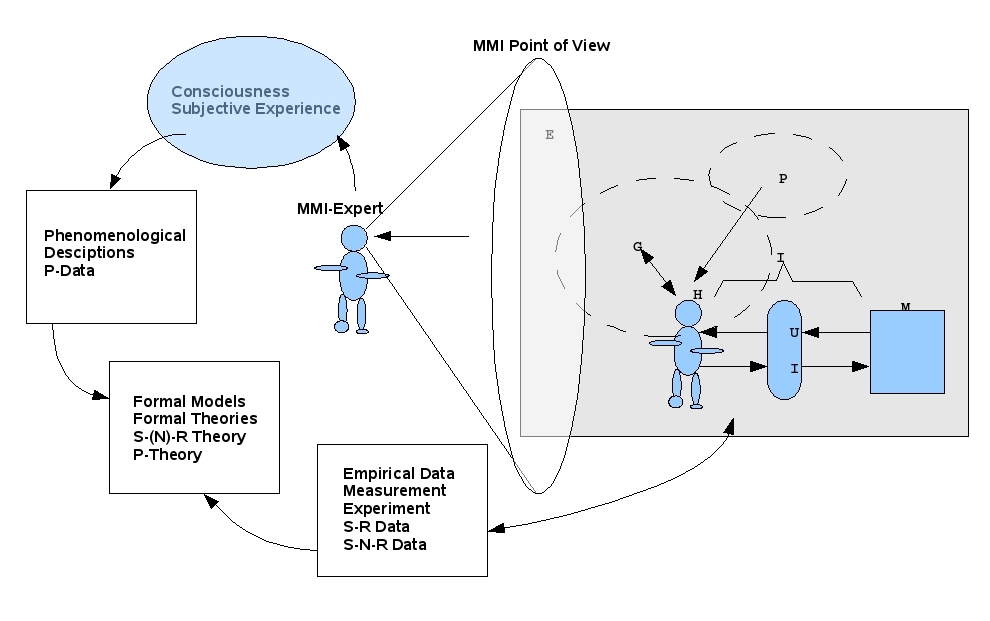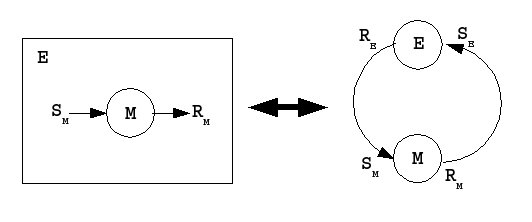
HMI/MMI/HCI
|
As outlined in the the Main
elements the main intention of MMI is the investigation and
evaluation of the intended application scenario. The question is how
this can be done.
 |
| Figure: MMI Process |
(1) The primary view for every kind of investigation is the subjective view of the users and the observers. This subjective view is rooted in the individual consciousness of every participant in the application scenario. The problem with this subjective view is, that it is mostly very fuzzy, difficult to reproduce and therefore it is difficult to built on these grounds far reaching agreements. Nevertheless is this subjective view the primary source of knowledge and it is necessary to represent the subjective knowledge in some written form which we will call here the P-Data. 'P' stands here for 'phenomena'. This is a term which has been introduced by philosophy to classify the epistemological status of the content of the subjective experience (--> Read some book in Philosophy about Phenomenology; see especially Edmund Husserl, the most important Phenomenologist).
(2) The historical efforts in trying to overcome the fuzziness and variance of subjective experience have lead to the invention of the empirical paradigm. This is the introduction of measurement methods which are independent of the subjective states of a single person but are bound to certain kinds of behaviors and agreed objects (= standards), which constitute a procedure whose results are E-Data (= Empirical Data). In an objective (= not subjective) method of measurement the participants apply a standard object S in an agreed way to some target object O. Comparing the target object O with the standard object S results in the computation of some value V which uses the standard object as measurement unit (U). Classical examples for such measurement units are the 'kg' for weighting, the 'm' for length and 's' for time (see a more elaborated presentation at the BIPM (Bureau International des Poids et Mesures)(URL: http://www.bipm.org/en/si/ ). Thus a measurement procedure results in an E-Datum like <N,U> like <4,m> telling that the target object has the value 4 of unit m.
Within this general view of measurement one has in the case of MMI to introduce some more special views. This results from the fact, that the objects of investigations in the case of MMI are human agents and machines which both can be understood as input-output systems sharing the same environment E (cf. figure). Thus to describe the dynamics of a biological input output system one has only the following basic options:
 |
| Figure: Input-Output System in environment E |
(i) Restricting to the observable behavior of a system based on stimuli S and responses R. This results in so called S-R-Data (behavioral data). This kind of observation applies to biological as well as technical systems. If a system is fairly complex (not linear) it is known that the behavior can not completely be analyzed only based on behavioral data. Therefore one needs additional data from the internal states of the system.
(ii) In the case of biological systems these internal states are so called physiological states. Within the physiological states are the neuronal states (N) the most prominent with regard to the behavior. Therefore one tries to correlate S-R-data with N-Data as S-N-R-Data to get more precise data for the investigations of the behavior of human persons.
The overall situation can then be described as follows:
(iii) On the non-empirical -- the subjective -- site we have only P-Data.
(iv) On the empirical site we have E-Data which are either general physical units like 'kg', 'm', 's' etc. or we have special kinds of data described as S-(N)-R-Data.
Having such data is a precondition for every kind of general statement about human persons interacting with machines in some environment. But the data as such don't allow any kind of general statement! Data are individual data, bound to a certain point of time at a certain limited part of space, a location. Data as such reveal never relations or dynamics or laws. To allow predictions from the present into the future one needs more general relations. These can only be introduced by minimal models or minimal theories.
(3) The necessity of minimal models/theories for predictions shows that the usage of data needs some interpretation. Interpretations are not a priori given; they have to be 'invented'. They can be wrong. Thus the introduction of a minimal model to interpret some data has to be evaluated/ tested by additional experiments. One can see this as a kind of a process:
(i) Having some first 'vague' idea
(iii) Making some measurements resulting in E-data ED1
(iv) Creating some minimal theory T1 to interpret the data ED1. That means the theory T1 contains at least one general relation which covers the data of ED1.
(v) To test the theory T1 one deduces some predictions of possible other data ED2' and makes experiments to generate such data. If an experiment EX1 generates data ED2 which are 'sufficiently in agreement with' ED2' then one can say that the data have 'confirmed' the theory T1. If not, then the case is not clear: was the experiment bad and not the theory false?. If no success occurs one can go back to step (iv) and try to set up some new theory T2 to cope with ED1 and ED2.
This process of theory building can be understood as a kind of 'inductive learning': the researches have no theory in the beginning. They start with first data, are using these data to 'find' some first structure 'fitting' to these data, and then they produce new hypotheses out of the first structure and the first data. With these <T1,ED1,ED2'> one can generate new experiments with new data, and repeat this.
From the real historical process of empirical and formal sciences we know, that the real process is fairly complex, probably until today not really and not fully understood. Thus this model of theory building is a simplified model, but it can help to show the basic structure of the process.